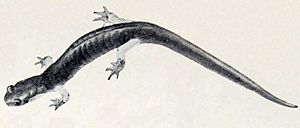Red-legged salamander facts for kids
Quick facts for kids Red-legged salamander |
|
|---|---|
 |
|
| Conservation status | |
| Scientific classification | |
| Genus: |
Plethodon
|
| Species: |
shermani
|
The red-legged salamander (Plethodon shermani) is a type of salamander found in the Plethodontidae family. It used to be thought of as a subspecies of the red-cheeked salamander. This amazing creature lives in the mountain forests of the southeastern United States.
Contents
What Does the Red-legged Salamander Look Like?
Red-legged salamanders are usually between 8.5 and 18.5 centimeters long. They have a body that is slate-grey to bluish-black. Their legs often have a bright red color on the top side. However, in the Unicoi Mountains, they might not have red legs at all. Instead, they can have white spots along their sides.
Male salamanders that are ready to mate have a special rounded gland under their chin. Young salamanders, called juveniles, might have pairs of red spots running down their backs. These salamanders lay their eggs on land, not in water.
Where Do Red-legged Salamanders Live?
These salamanders prefer cool, somewhat damp forests. They like to live in high places, such as the Unicoi and Nantahala mountains. They are also found in the southern Appalachian Mountains. Most red-legged salamanders live in North Carolina. However, you can also find them in northern Georgia and southeastern Tennessee.
Because they live in fewer than five known areas, this species is considered vulnerable to extinction. This means they could be at risk of disappearing if we don't protect their homes. During the day, these salamanders hide under logs or rocks. At night, they come out to search for food on the forest floor.
What Do Red-legged Salamanders Eat?
The red-legged salamander is a nocturnal hunter, meaning it hunts at night. It eats many different kinds of small invertebrates. These are tiny creatures without backbones, like insects and worms, that live on the forest floor.
How Do Red-legged Salamanders Communicate for Reproduction?
When it's time to mate, male salamanders in the Plethodontidae family use special protein chemicals called pheromones. These pheromones help make the female salamander more interested in mating.
Many types of salamanders put these pheromones onto the female's skin, usually on her back. The pheromones then go through her skin and into her body. This is a unique way for animals with backbones to share these special chemicals! However, red-legged salamanders are different. Males in their group put pheromones directly into the female's nose. The female then detects these chemicals with a special organ called the vomeronasal organ. This helps them communicate during courtship.
Scientists have studied how female red-legged salamanders react to these pheromones. They found that females are not affected by pheromones put on their skin. This suggests that all salamanders in the P. glutinosus group, which includes the red-legged salamander, use their sense of smell for these important mating signals.
Protecting Red-legged Salamanders
Much of where these salamanders live is within the Nantahala National Forest. Some tree cutting, called clear-cutting, happens there. However, efforts are being made to help protect these salamanders. This species is not currently on any state or federal list of endangered animals.
Red-legged salamanders are quite strong and can handle some changes to their environment. This includes things like logging operations. You can often find them in forests that have grown back after being cut down. They can even live in smaller, separated areas of woodland.


